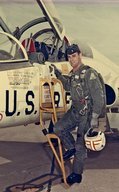
|

|
|
|
|
Carl was born in Los Angeles, California, during World War II, to Carl Frederick Pampe and Mary Louise Minkler Pampe. His father was a captain in the Army Coast Artillery, stationed in nearby Venice. "They just knew the Japanese were going to attack the west coast, so he was there to shoot them down if they did," Carl recalls. Later sent overseas, his father served in the China-Burma-India Theater with the 843rd Airborne Anti-Aircraft Artillery. After the war, the elder Pampe went to work as a petroleum geologist. "My dad kind of raised a family like a military company," says Carl, who grew up near Clay City, Illinois, where the Pampes lived in an oil camp of the Pure Oil Company, his father's employer. "All the oil companies had camps and there were row houses and most all of them were white," he recalls. "Pure had blue trim around the windows." When Pure transferred his father to Shreveport, Carl entered Byrd High School where he joined Junior Army R.O.T.C. Graduating in 1961, he enrolled at Louisiana Tech University in Ruston, where he joined Air Force R.O.T.C. After graduating in May of 1967 he entered Officers' Candidate School in San Antonio, and was commissioned a second lieutenant in May of 1968. Carl took pilot training in Del Rio, Texas. He preferred not to be a fighter pilot. "The whole fighter mentally, that `go kill,' you know, `blow up something,' it never impressed me," he says. He graduated in May of 1969 and was assigned to the EC-47, a tactical reconnaissance aircraft also known as a Gooney Bird. After flight training he attended a survival school in Spokane, Washington, then another at Clark Air Force Base in the Philippines. Sent to Vietnam in September of 1969, he was assigned to the 361st Tactical Electronic Warfare Squadron, based at Phuket, Thailand. Carl began flying as co-pilot on highly classified missions, many lasting around seven hours, to locate enemy positions. He calls his time in Vietnam as "the greatest flying I ever did." He also felt safe. "I was, statistically, a lot safer flying combat missions in a Gooney Bird than I would have been if I was driving an equal number of hours up and down the road in the United States." He adds: "There were more people killed on the highways in the United States the year I was over there than were the whole time we were in Vietnam." Meanwhile, he was corresponding with Rochelle Crites, a U.S. Air Force nurse he had met in Del Rio. Carl returned from Vietnam in September of 1970, having earned a Distinguished Flying Cross. At Grissom Air Force Base in Indianapolis, he was assigned to the 70th Air Refueling Squadron of the 305th Air Refueling Wing, where he qualified to become an instructor. He trained in the KC-135, a tanker aircraft, at Castle Air Force Base near San Jose, California, where he also went through Central Flight Instructor Course (CFIC). He and Rochelle married in November of 1970. (They would have two children.) Carl returned to Vietnam as a KC-135 pilot three times on temporary duty missions of sixty and ninety days. In all, he flew 197 combat missions, chalking up approximately 1,300 combat hours. Promoted to captain, he served nearly nine years at Castle before being sent to Barksdale Air Force Base in Bossier City, Louisiana, where he served from May of 1979 until his retirement in 1989. Rochelle passed away in March of 1985. |


